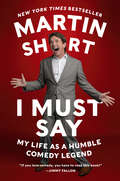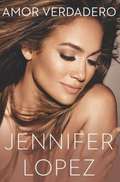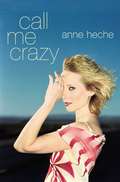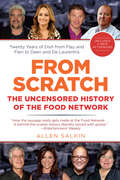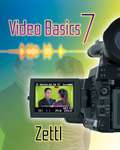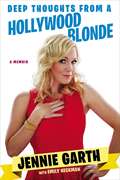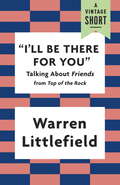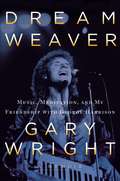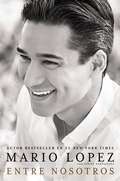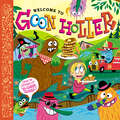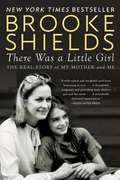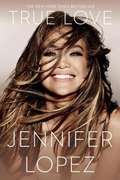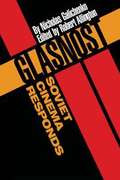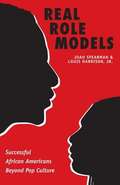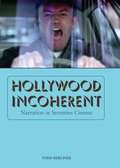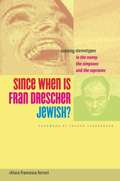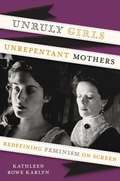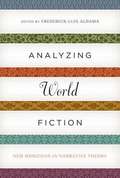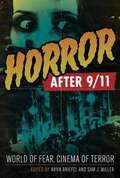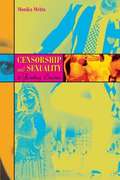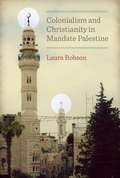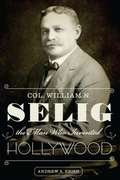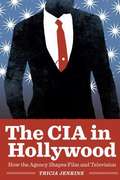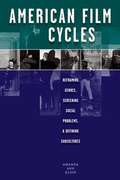- Table View
- List View
I Must Say
by Martin ShortIn this engagingly witty, wise, and heartfelt memoir, Martin Short tells the tale of how a showbiz obsessed kid from Canada transformed himself into one of Hollywood's favorite funnymen, known to his famous peers as the "comedian's comedian."Short takes the reader on a rich, hilarious, and occasionally heartbreaking ride through his life and times, from his early years in Toronto as a member of the fabled improvisational troupe Second City to the all-American comic big time of Saturday Night Live, and from memorable roles in such movies as ¡Three Amigos! and Father of the Bride to Broadway stardom in Fame Becomes Me and the Tony-winning Little Me.He reveals how he created his most indelible comedic characters, among them the manic man-child Ed Grimley, the slimy corporate lawyer Nathan Thurm, and the bizarrely insensitive interviewer Jiminy Glick. Throughout, Short freely shares the spotlight with friends, colleagues, and collaborators, among them Steve Martin, Tom Hanks, Gilda Radner, Mel Brooks, Nora Ephron, Eugene Levy, Catherine O'Hara, Paul Shaffer, and David Letterman.But there is another side to Short's life that he has long kept private. He lost his eldest brother and both parents by the time he turned twenty, and, more recently, he lost his wife of thirty years to cancer. In I Must Say, Short talks for the first time about the pain that these losses inflicted and the upbeat life philosophy that has kept him resilient and carried him through.In the grand tradition of comedy legends, Martin Short offers a show-business memoir densely populated with boldface names and rife with retellable tales: a hugely entertaining yet surprisingly moving self-portrait that will keep you laughing--and crying--from the first page to the last.
Amor Verdadero
by Jennifer LopezEn Amor verdadero, Lopez explora uno de los períodos más decisivos de su vida: el viaje de transformación que duró dos años, donde ella cuenta cómo, siendo madre y artista, afrentó sus mayores retos, identificó sus miedos más grandes y, en última instancia, terminó siendo una persona más fuerte que nunca antes. Esta publicación, visualmente llamativa, está acompañada de fotografías íntimas, electrizantes y nunca antes vistas. Escrito como un diario personal con lecciones duramente aprendidas y recuerdos sinceros, Amor verdadero es una historia motivadora de auto-reflexión, reencuentro y resiliencia.
Call Me Crazy
by Anne HecheA beautifully written and evocative memoir of pain and redemption, of hurt and healing, from an actress whose private life and personal choices have made her a household name. "My life is a life movies are made of," wrote Anne Heche in the proposal for her memoir. Yet what is truly surprising about Heche is that the most publicized event of her past -- her romance with Ellen DeGeneres -- is only one development in a fascinating and difficult life that has included more than its share of heartache and tragedy. Heche's memoir reveals the woman behind the headlines, one who has conquered overwhelming odds. Far from a celebrity memoir, this is an empowering and thought-provoking book guaranteed to surprise and inspire.
From Scratch
by Allen SalkinTwenty Years of Dish from Flay and Fieri to Deen and DeLaurentiis... Includes a New Afterword! I don t want this shown. I want the tapes of this whole series destroyed. Martha Stewart In those days, the main requirement to be on the Food Network was being able to get there by subway. Bobby Flay She seems to suggest that you can make good food easily, in minutes, using Cheez Whiz and chopped-up Pringles and packaged chili mix. Anthony Bourdain This is the definitive history of The Food Network from its earliest days as a long-shot business gamble to its current status as a cable obsession for millions, home along the way to such icons as Emeril Lagasse, Rachael Ray, Mario Batali, Alton Brown, and countless other celebrity chefs. Using extensive inside access and interviews with hundreds of executives, stars, and employees, From Scratch is a tantalizing, delicious look at the intersection of business, pop culture, and food. INCLUDES PHOTOS But what we don't know about them, and the people behind them, could fill a book. Based upon extensive inside access, documents, and interviews with hundreds of executives, stars, and employees all up and down the ladder, Allen Salkin's book is an exhilarating roller-coaster ride from chaos to conquest (and sometimes back). As Salkin takes us inside the conference rooms, studios, homes, restaurants, and after-hours meetings, we see a salty Julia Child lording it over the early network performers; a fragile Emeril Lagasse staggering from the sudden public shock of cancellation; a very green Rachael Ray nearly burning down the set on her first day; a torn Tyler Florence accepting the Applebee's job he knows he can't refuse, but with a chill running down his spine; a determined Bobby Flay reinventing himself once again to survive. Paula Deen, Tom Colicchio, Anthony Bourdain, Mario Batali, Jamie Oliver, Martha Stewart, Guy Fieri, Cat Cora: Salkin illuminates the people we thought we knew, and the ones we never knew about, in this irresistible story of the intersection between business, television, pop culture, food--and us.
Video Basics 7
by Herbert ZettlHerbert Zettl draws on his expertise and field experience to bring you the seventh edition of VIDEO BASICS, the handiest and most authoritative, current, and technically accurate student guide to video production available. Meeting the need for a briefer book, this text distills comprehensive video instruction so that it can be covered in a single semester. The book moves students from video concepts and processes to production tools and techniques and, finally, to the production environment (studio and field, inside and outside) and its effects. A more conceptual framework leads students from the idea (what to create) to the image (how to create) on video.
Deep Thoughts From a Hollywood Blonde
by Jennie Garth Emily HeckmanFor the first time ever, Jennie Garth is putting it all out there, sharing her joys and her sorrows, her successes and her failures, with candor and a surprising, even bawdy, sense of humor. From her sudden rise to fame as a golden-haired teen beauty, to recently redefining herself as a single working mother to three growing girls, Jennie Garth has defied the odds and thrived in a town that can be more than a little tough on its blondes. Since Jennie landed in Hollywood at just sixteen, she has built an enduring career as a television and film actress, producer and director, beginning with her iconic turn as Kelly Taylor on Aaron Spelling's smash hit Beverly Hills 90210, a show that ran for a decade and which cemented Jennie's place in American pop culture. Recently, Jennie found herself facing her forties from a place she never expected to be in: newly single, in demand again as an actress after years spent focusing on her family, and all over the tabloids. So she decided to do what surprised many#151;including herself: she decided to write about it, to tell her own story, in her own words. And now, in this intimate memoir, she explores the highs and lows of her life, both in front of the camera and behind closed doors, revealing the real Jennie Garth#151;smart, funny, and stronger than she ever realized. This is one unforgettable, utterly loveable Hollywood Blonde, and these are her deep thoughts. "No one warned me that deciding to write a book about my life would unleash all of the insecurities, fears, and self-doubts I'd been trying to outwit and outrun my whole life, but that's exactly what happened. I wanted to tell my truth with as much courage as I could muster and to be as fearless as possible as I delved into the darker corners of my mind. The result surprised me: I got to know myself in new ways. Revealing myself in these pages has been at times terrifying, but also one of the most liberating experiences of my life. That's because once you start writing, all of these embarrassing, wonderful, hilarious, painful, and surreal things that make you who you are get flushed up to the surface. And so word by word, I began to put the story of me together. Now all of these personal recollections, memories and anecdotes have been printed and bound into this book, which means that now you get to know me, too. " #151;Jennie Garth
"I'll Be There for You"
by Warren LittlefieldAn eBook short.A behind-the-scenes look at Friends, one of the most popular TV shows of all time--a wide-ranging interview with the cast and creators, excerpted from Top of the Rock, by former NBC President of Entertainment Warren LittlefieldIt was a little show originally called Six of One, whose pilot only tested decently with audiences--but all of that would soon change. "I'll Be There for You" presents a colorful, funny, and enlightening oral history drawn from the actors and creators of Friends. Outlining the whole history of the show, from first episode to last, including testimonials straight from the studio floor, this selection reveals the personal side of the "Shakespearean soap opera," including how the actors dealt with fame, helped to create their roles, negotiated and grew together as one family, and (of course) how Joey became Joey.
Georgia Music
by Helen V. GriffithA little girl and her grandfather share two different kinds of music, that of his mouth organ and that of the birds and insects around his cabin.
Dream Weaver: A Memoir; Music, Meditation, and My Friendship with George Harrison
by Gary WrightMusic legend Gary Wright reflects on his professional collaboration, friendship, and spiritual journey with "quiet Beatle" George Harrison. Best known for his multiplatinum hits "Dream Weaver" and "Love is Alive," Gary Wright came to prominence as a singer and songwriter during the golden age of rock in the 1970s. What is not as well known to the public, however, is Wright's spiritual side. At the heart of this memoir is the spiritual conversion and journey that Wright experienced alongside his close friend George Harrison. Until Harrison's death in 2001, the two spent decades together writing songs, eating Indian fare, talking philosophy, and gardening. In addition to featuring lyrics to a never-released recording of a song cowritten by Wright and George Harrison in 1971, titled "To Discover Yourself," this memoir includes a cache of never-before-seen photos. Also available is a deluxe e-book featuring an audio recording of "To Discover Yourself."
Entre nosotros
by Mario Lopez Steve SantagatiCon una estrella que se elevó de los inolvidables papeles que interpretó de niño como A.C. Slater en Saved by the Bell a la vanguardia de los medios de entretenimiento de hoy en día, Mario Lopez es nada menos que una sensación de la cultura pop. Ahora que está a punto de cumplir cuarenta años, Mario mira su vida con una perspectiva renovada, humor y sensibilidad de cómo las cosas han cambiado con la edad. Por primera vez divulga las experiencias entrañables, sorprendentes y algunas veces difíciles que lo convirtieron en el padre y esposo amoroso que es hoy. En Entre nosotros, Mario narra, con absoluta honestidad, sus éxitos y sus decepciones en el mundo del entretenimiento y cómo el amor de su familia y sus fuertes valores personales lo ayudaron a mantenerse centrado sin importar lo que pudiera traerle la vida. Con ingenio y candor, Mario revela sus historias más íntimas, las que jamás ha contado, incluyendo detalles acerca de su tumultuosa y muy pública vida amorosa, ofreciendo a sus lectores un vistazo a los altibajos de su pasado romántico que lo condujo hasta la vida feliz que lleva con su bella esposa y sus dos hijos. Por primera vez y sin filtros, Mario Lopez.
Welcome to Goon Holler
by Christian Jacobs Parker JacobsThe first book in a new, vibrantly hip illustrated series from the creators of Yo Gabba Gabba!Features Read-Aloud/Read-to-Me functionality where available.Tooba, a shy and unassuming bigfoot, stumbles through a waterfall into Goon Holler, a new and exciting world. There, he meets a feisty little gal named Dosie. She teaches him it's fun to meet new people and try new things--especially when the people are goons and the things are delicious, steaming-hot pancakes!
There Was a Little Girl
by Brooke ShieldsActress and author of the New York Times bestseller Down Came the Rain, Brooke Shields, explores her relationship with her unforgettable mother, Teri, in her new memoir. Brooke Shields never had what anyone would consider an ordinary life. She was raised by her Newark-tough single mom, Teri, a woman who loved the world of show business and was often a media sensation all by herself. Brooke's iconic modeling career began by chance when she was only eleven months old, and Teri's skills as both Brooke's mother and manager were formidable. But in private she was troubled and drinking heavily.As Brooke became an adult the pair made choices and sacrifices that would affect their relationship forever. And when Brooke's own daughters were born she found that her experience as a mother was shaped in every way by the woman who raised her. But despite the many ups and downs, Brooke was by Teri's side when she died in 2012, a loving daughter until the end.Only Brooke knows the truth of the remarkable, difficult, complicated woman who was her mother. And now, in an honest, open memoir about her life growing up, Brooke will reveal stories and feelings that are relatable to anyone who has been a mother or daughter.
True Love
by Jennifer LopezIn Jennifer Lopez's first ever book, True Love, she explores one of her life's most defining periods--the transformative two-year journey of how, as an artist and a mother, she confronted her greatest challenges, identified her biggest fears, and ultimately emerged a stronger person than she's ever been. Guided by both intimate and electrifying photographs, True Love an honest and revealing personal diary with hard-won lessons and heartfelt recollections and an empowering story of self-reflection, rediscovery, and resilience. Completely full-color, with photos throughout and lavishly designed, True Love is a stunning and timeless book that features more than 200 never-before-seen images from Lopez's personal archives, showing candid moments with her family and friends and providing a rare behind-the-scenes look at the life of a pop music icon travelling, rehearsing, and performing around the world.
Glasnost--Soviet Cinema Responds
by Nicholas Galichenko edited by Robert AllingtonWith the coming of glasnost to the Soviet Union, filmmakers began to explore previously forbidden themes, and distributors released films that were suppressed by pre-glasnost-era censors. Soviet cinema underwent a revolution, one that mirrors and helps interpret the social revolution that took place throughout the USSR. Glasnost-Soviet Cinema Responds is the first overall survey of the effects of this revolution on the work of Soviet filmmakers and their films. The book is structured as a series of three essays and a filmography of the directors of glasnost cinema. The first essay, "The Age of Perestroika," describes the changes that occurred in Soviet cinema as it freed itself from the legacy of Stalinism and socialist realism. It also considers the influence of film educator and director Mikhail Romm. "Youth in Turmoil" takes a sociological look at films about youth, the most dynamic and socially revealing of glasnost-era productions. "Odysseys in Inner Space" charts a new direction in Soviet cinema as it focuses on the inner world of individuals. The filmography includes thirty-three of the most significant glasnost-era directors, including Tengiz Abuladze, Karen Shakhnazarov, and Sergei Soloviev, with a comprehensive list of their films. Discussions of many individual films, such as Repentance, The Messenger Boy, and The Wild Pigeon, and interviews with the directors reveal the effects that glasnost and perestroika have had on the directors' lives and art.
Real Role Models
by Joah SpearmanAll young people need good role models, and black youth especially need positive and real examples beyond the famous and wealthy people they see on SportsCenter highlights and MTV Cribs. While success as a celebrity athlete or entertainer may seem like an achievable dream, the reality is that young African Americans have a much greater chance of succeeding in the professions through education and hard work--and a mentor to show them the path. Real Role Models introduces high school and college-age African Americans to twenty-three black professionals who have achieved a high level of success in their chosen fields and who tell their stories to inspire young people to pursue a professional career and do the work necessary to achieve their dreams. Some of the individuals profiled by Joah Spearman and Louis Harrison, Jr. , include Leonard Pitts, Pulitzer Prize-winning columnist for the Miami Herald; Melody Barnes, Director of the White House Domestic Policy Council; Danyel Smith, editor-in-chief of Vibe; and Dr. Tim George, Chief of Pediatric Neuroscience at Dell Children's Medical Center of Central Texas. They and other interviewees describe their backgrounds, career paths, and desire to give back by helping others reach their goals. Representing a wide range of occupations, these real role models prove to African American youths that a whole world of successful, rewarding careers awaits them. The Real Role ModelsRufus Cormier, JD, Partner at the Baker Botts Law Firm, Houston, TexasMelody Barnes, Director of the White House Domestic Policy Council, Washington, D. C. Eric Motley, PhD, Managing Director of the Aspen Institute's Henry Crown Fellowship Program, Aspen, ColoradoJames McIntyre, Spokesman for the Federal Emergency Management Agency, Washington, D. C. Tracie Hall, Assistant Dean and Librarian at Dominican University, River Forest, IllinoisKimberlydawn Wisdom, MD, Surgeon General of the State of Michigan, Lansing, MichiganTimothy George, MD, Chief of Pediatric Neuroscience at Dell Children's Medical Center, Austin, TexasVictoria Holloway Barbosa, MD, Ethnic Dermatologist and Former Executive for L'Oreal, Chicago, IllinoisBill Douglas, White House Correspondent for McClatchy Newspapers, Washington, D. C. Leonard Pitts, Jr. , Columnist for the Miami Herald, Miami, FloridaDanyel Smith, Editor of Vibe Magazine, New York, New YorkEd Stewart, Managing Director of External Communications for Delta Airlines, Atlanta, GeorgiaLynn Tyson, Vice President of Investor Relations for Dell, Austin, TexasWillie Miles, Jr. , Founder and CEO of Miles Wealth Management, Houston, TexasHorace Allen, Founder and CEO of TeamPact, Atlanta, GeorgiaDeavra Daughtry, President and CEO of Excellent Care Management, Houston, TexasJe'Caryous Johnson, Founder and CEO of I'm Ready Productions, Houston, TexasSteve Jones, Cofounder of a graphic design company, Oakland, CaliforniaIsiah Warner, PhD, Chemistry Professor at Louisiana State University, Baton Rouge, LouisianaGloria Ladson-Billings, PhD, Professor of Education at the University of Wisconsin, Madison, WisconsinBernard Muir, Athletic Director at Georgetown University, Washington, D. C. Craig Littlepage, Athletic Director at the University of Virginia, Charlottesville, VirginiaBeverly Kearney, Women's Track Coach at the University of Texas at Austin, Austin, Texas
Hollywood Incoherent: Narration in Seventies Cinema
by Todd BerlinerIn the 1970s, Hollywood experienced a creative surge, opening a new era in American cinema with films that challenged traditional modes of storytelling. Inspired by European and Asian art cinema as well as Hollywood’s own history of narrative ingenuity, directors such as Martin Scorsese, Robert Altman, William Friedkin, Stanley Kubrick, Woody Allen, and Francis Ford Coppola undermined the harmony of traditional Hollywood cinema and created some of the best movies ever to come out of the American film industry. Critics have previously viewed these films as a response to the cultural and political upheavals of the 1970s, but until now no one has explored how the period’s inventive narrative design represents one of the great artistic accomplishments of American cinema. In Hollywood Incoherent, Todd Berliner offers the first thorough analysis of the narrative and stylistic innovations of seventies cinema and its influence on contemporary American filmmaking. He examines not just formally eccentric films—Nashville; Taxi Driver; A Clockwork Orange; The Godfather, Part II; and the films of John Cassavetes—but also mainstream commercial films, including The Exorcist, The Godfather, The French Connection, Willy Wonka and the Chocolate Factory, Dog Day Afternoon, Chinatown, The Bad News Bears, Patton, All the President’s Men, Annie Hall, and many others. With persuasive revisionist analyses, Berliner demonstrates the centrality of this period to the history of Hollywood’s formal development, showing how seventies films represent the key turning point between the storytelling modes of the studio era and those of modern American cinema.
Since When Is Fran Drescher Jewish?: Dubbing Stereotypes in The Nanny, The Simpsons, and The Sopranos
by Ferrari Chiara Francesca"Since when is Fran Drescher Jewish?" This was Chiara Francesca Ferrari's reaction when she learned that Drescher's character on the television sitcom The Nanny was meant to be a portrayal of a stereotypical Jewish-American princess. Ferrari had only seen the Italian version of the show, in which the protagonist was dubbed into an exotic, eccentric Italian-American nanny. Since When Is Fran Drescher Jewish? explores this "ventriloquism" as not only a textual and cultural transfer between languages but also as an industrial practice that helps the media industry foster identification among varying audiences around the globe. At the heart of this study is an in-depth exploration of three shows that moved from global to local, mapping stereotypes from both sides of the Atlantic in the process. Presented in Italy, for example, Groundskeeper Willie from The Simpsons is no longer a belligerent, alcoholic Scotsman but instead easily becomes a primitive figure from Sardinia. Ironically, The Sopranos - a show built around Italian-Americans - was carefully re-positioned by Italian TV executives, who erased the word "mafia" and all regional references to Sicily. The result of Ferrari's three case studies is evidence that "otherness" transcends translation, as the stereotypes produced by the American entertainment industry are simply replaced by other stereotypes in foreign markets. As American television studios continue to attempt to increase earnings by licensing their shows abroad, Since When Is Fran Drescher Jewish? illuminates the significant issues of identity raised by this ever-growing marketplace, along with the intriguing messages that lie in the larger realm of audiovisual cultural exchange.
Unruly Girls, Unrepentant Mothers
by Kathleen Rowe KarlynSince the 1990s, when Reviving Ophelia became a best seller and “Girl Power” a familiar anthem, girls have assumed new visibility in the culture. Yet in asserting their new power, young women have redefined femininity in ways that have often mystified their mothers. They have also largely disavowed feminism, even though their new influence is a likely legacy of feminism’s Second Wave. At the same time, popular culture has persisted in idealizing, demonizing, or simply erasing mothers, rarely depicting them in strong and loving relationships with their daughters. Unruly Girls, Unrepentent Mothers, a companion to Kathleen Rowe Karlyn’s groundbreaking work, The Unruly Woman, studies the ways popular culture and current debates within and about feminism inform each other. Surveying a range of films and television shows that have defined girls in the postfeminist era—from Titanic and My So-Called Life to Scream and The Devil Wears Prada, and from Love and Basketball to Ugly Betty—Karlyn explores the ways class, race, and generational conflicts have shaped both Girl Culture and feminism’s Third Wave. Tying feminism’s internal conflicts to negative attitudes toward mothers in the social world, she asks whether today’s seemingly materialistic and apolitical girls, inspired by such real and fictional figures as the Spice Girls and Buffy the Vampire Slayer, have turned their backs on the feminism of their mothers or are redefining unruliness for a new age.
Analyzing World Fiction
by Frederick Luis AldamaWhy are many readers drawn to stories that texture ethnic experiences and identities other than their own? How do authors such as Salman Rushdie and Maxine Hong Kingston, or filmmakers in Bollywood or Mexico City produce complex fiction that satisfies audiences worldwide? In Analyzing World Fiction, fifteen renowned luminaries use tools of narratology and insights from cognitive science and neurobiology to provide answers to these questions and more. With essays ranging from James Phelan’s “Voice, Politics, and Judgments in Their Eyes Were Watching God” and Hilary Dannenberg’s “Narrating Multiculturalism in British Media: Voice and Cultural Identity in Television” to Ellen McCracken’s exploration of paratextual strategies in Chicana literature, this expansive collection turns the tide on approaches to postcolonial and multicultural phenomena that tend to compress author and narrator, text and real life. Striving to celebrate the art of fiction, the voices in this anthology explore the “ingredients” that make for powerful, universally intriguing, deeply human story-weaving. Systematically synthesizing the tools of narrative theory along with findings from the brain sciences to analyze multicultural and postcolonial film, literature, and television, the contributors pioneer new techniques for appreciating all facets of the wonder of storytelling.
Horror after 9/11
by Aviva Briefel Sam J. MillerHorror films have exploded in popularity since the tragic events of September 11, 2001, many of them breaking box-office records and generating broad public discourse. These films have attracted A-list talent and earned award nods, while at the same time becoming darker, more disturbing, and increasingly apocalyptic. Why has horror suddenly become more popular, and what does this say about us? What do specific horror films and trends convey about American society in the wake of events so horrific that many pundits initially predicted the death of the genre? How could American audiences, after tasting real horror, want to consume images of violence on screen? Horror after 9/11 represents the first major exploration of the horror genre through the lens of 9/11 and the subsequent transformation of American and global society. Films discussed include the Twilight saga; the Saw series; Hostel; Cloverfield; 28 Days Later; remakes of The Texas Chainsaw Massacre, Dawn of the Dead, and The Hills Have Eyes; and many more. The contributors analyze recent trends in the horror genre, including the rise of ‘torture porn,’ the big-budget remakes of classic horror films, the reinvention of traditional monsters such as vampires and zombies, and a new awareness of visual technologies as sites of horror in themselves. The essays examine the allegorical role that the horror film has held in the last ten years, and the ways that it has been translating and reinterpreting the discourses and images of terror into its own cinematic language.
Censorship and Sexuality in Bombay Cinema
by Monika MehtaIndia produces an impressive number of films each year in a variety of languages. Here, Monika Mehta breaks new ground by analyzing Hindi films and exploring the censorship of gender and heterosexuality in Bombay cinema. She studies how film censorship on various levels makes the female body and female sexuality pivotal in constructing national identity, not just through the films themselves but also through the heated debates that occur in newspapers and other periodicals. The standard claim is that the state dictates censorship and various prohibitions, but Mehta explores how relationships among the state, the film industry, and the public illuminate censorship's role in identity formation, while also examining how desire, profits, and corruption are generated through the act of censoring. Committed to extending a feminist critique of mass culture in the global south, Mehta situates the story of censorship in a broad social context and traces the intriguing ways in which the heated debates on sexuality in Bombay cinema actually produce the very forms of sexuality they claim to regulate. She imagines afresh the theoretical field of censorship by combining textual analysis, archival research, and qualitative fieldwork. Her analysis reveals how central concepts of film studies, such as stardom, spectacle, genre, and sound, are employed and (re)configured within the ambit of state censorship, thereby expanding the scope of their application and impact.
Colonialism and Christianity in Mandate Palestine
by Laura RobsonDrawing on a rich base of British archival materials, Arabic periodicals, and secondary sources, Colonialism and Christianity in Mandate Palestine brings to light the ways in which the British colonial state in Palestine exacerbated sectarianism. By transforming Muslim, Christian, and Jewish religious identities into legal categories, Laura Robson argues, the British ultimately marginalized Christian communities in Palestine. Robson explores the turning points that developed as a result of such policies, many of which led to permanent changes in the region's political landscapes. Cases include the British refusal to support Arab Christian leadership within Greek-controlled Orthodox churches, attempts to avert involvement from French or Vatican-related groups by sidelining Latin and Eastern Rite Catholics, and interfering with Arab Christians' efforts to cooperate with Muslims in objecting to Zionist expansion. Challenging the widespread but mistaken notion that violent sectarianism was endemic to Palestine, Colonialism and Christianity in Mandate Palestine shows that it was intentionally stoked in the wake of British rule beginning in 1917, with catastrophic effects well into the twenty-first century.
Col. William N. Selig: The Man Who Invented Hollywood
by Andrew A. ErishAll histories of Hollywood are wrong. Why? Two words: Colonel Selig. This early pioneer laid the foundation for the movie industry that we know today. Active from 1896 to 1938, William N. Selig was responsible for an amazing series of firsts, including the first two-reel narrative film and the first two-hour narrative feature made in America; the first American movie serial with cliffhanger endings; the first westerns filmed in the West with real cowboys and Indians; the creation of the jungle-adventure genre; the first horror film in America; the first successful American newsreel (made in partnership with William Randolph Hearst); and the first permanent film studio in Los Angeles. Selig was also among the first to cultivate extensive international exhibition of American films, which created a worldwide audience and contributed to American domination of the medium. In this book, Andrew Erish delves into the virtually untouched Selig archive at the Academy of Motion Picture Arts and Sciences Library to tell the fascinating story of this unjustly forgotten film pioneer. He traces Selig's career from his early work as a traveling magician in the Midwest, to his founding of the first movie studio in Los Angeles in 1909, to his landmark series of innovations that still influence the film industry. As Erish recounts the many accomplishments of the man who first recognized that Southern California is the perfect place for moviemaking, he convincingly demonstrates that while others have been credited with inventing Hollywood, Colonel Selig is actually the one who most deserves that honor.
The CIA in Hollywood: How the Agency Shapes Film and Television
by Tricia JenkinsWhat’s your impression of the CIA? A bumbling agency that can’t protect its own spies? A rogue organization prone to covert operations and assassinations? Or a dedicated public service that advances the interests of the United States? Astute TV and movie viewers may have noticed that the CIA’s image in popular media has spanned this entire range, with a decided shift to more positive portrayals in recent years. But what very few people know is that the Central Intelligence Agency has been actively engaged in shaping the content of film and television, especially since it established an entertainment industry liaison program in the mid-1990s. The CIA in Hollywood offers the first full-scale investigation of the relationship between the Agency and the film and television industries. Tricia Jenkins draws on numerous interviews with the CIA’s public affairs staff, operations officers, and historians, as well as with Hollywood technical consultants, producers, and screenwriters who have worked with the Agency, to uncover the nature of the CIA’s role in Hollywood. In particular, she delves into the Agency’s and its officers’ involvement in the production of The Agency, In the Company of Spies, Alias, The Recruit, The Sum of All Fears, Enemy of the State, Syriana, The Good Shepherd, and more. Her research reveals the significant influence that the CIA now wields in Hollywood and raises important and troubling questions about the ethics and legality of a government agency using popular media to manipulate its public image.
American Film Cycles
by Amanda Ann KleinA series of movies that share images, characters, settings, plots, or themes, film cycles have been an industrial strategy since the beginning of cinema. While some have viewed them as “subgenres,” mini-genres, or nascent film genres, Amanda Ann Klein argues that film cycles are an entity in their own right and a subject worthy of their own study. She posits that film cycles retain the marks of their historical, economic, and generic contexts and therefore can reveal much about the state of contemporary politics, prevalent social ideologies, aesthetic trends, popular desires, and anxieties. American Film Cycles presents a series of case studies of successful film cycles, including the melodramatic gangster films of the 1920s, the 1930s Dead End Kids cycle, the 1950s juvenile delinquent teenpic cycle, and the 1990s ghetto action cycle. Klein situates these films in several historical trajectories—the Progressive movement of the 1910s and 1920s, the beginnings of America’s involvement in World War II, the “birth” of the teenager in the 1950s, and the drug and gangbanger crises of the early 1990s. She shows how filmmakers, audiences, film reviewers, advertisements, and cultural discourses interact with and have an impact on the film texts. Her findings illustrate the utility of the film cycle in broadening our understanding of established film genres, articulating and building upon beliefs about contemporary social problems, shaping and disseminating deviant subcultures, and exploiting and reflecting upon racial and political upheaval.
